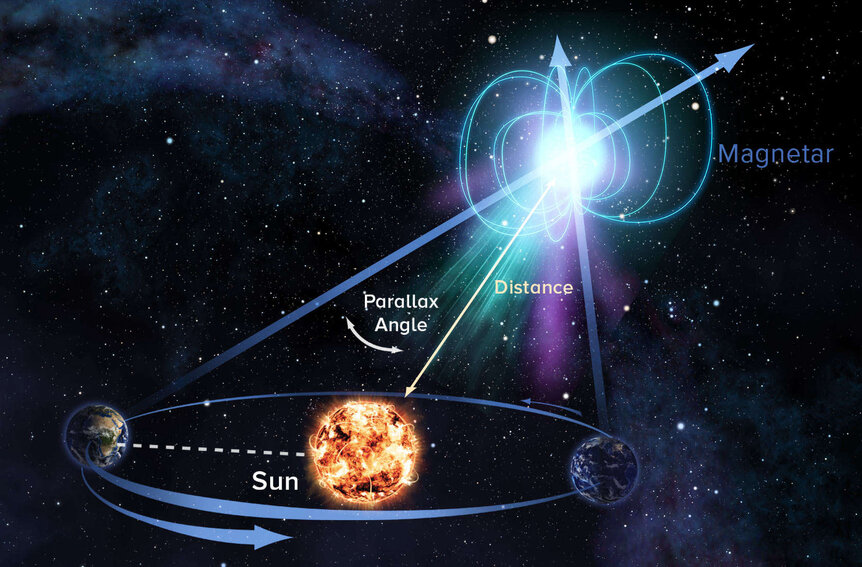Create a free profile to get unlimited access to exclusive videos, sweepstakes, and more!
Now we know just how far away a magnetar is

People think black holes are scary, and I get that, I really do. But to me, the scariest objects in space aren't black holes. They're magnetars.
These are a special kind of neutron stars, which are scary enough as is. When a massive star explodes at the end of its life as a supernova, only the outer layers are blasted away. The core collapses to form an unreasonably dense sphere about 24 – 28 kilometers across. This object can have a mass over twice that of the Sun but packed into a ball only a quadrillionth the volume.
The surface gravity can be a hundred million times Earth's — on a neutron star I'd weigh well over 7 billion tons — and the magnetic field can be many billions of times stronger than Earth's. Neutron stars terrifying.
But magnetars are a whole 'nuther class of them. For reasons still not completely understood they can have magnetic fields thousands of times stronger yet, some of which top out at a quadrillion times that of the Earth's. The magnetism is so strong it can dominate the surface of a magnetar even over the ridiculous gravity!
They also undergo fantastically powerful explosive events, called flares, that are so immense that they can physically affect objects around them for distances of tens of thousands of light years. In 2004 one such flare from a magnetar physically compressed Earth's magnetic field even though it was 50,000 light years away!
We have lots of theoretical models on how they behave, but a big limitation in comparing them to observations (which is how you validate or refute the model) is that we don't have good distance measurements to magnetars. They're all thousands of light years away (or in other galaxies), and astronomers tend to use indirect methods to get the distance, which can have large uncertainties.
The good news is that, for the first time, a team of astronomers has directly measured the distance to a magnetar.
It's called XTE J1810-197, and was discovered in 2003. Of the roughly 30 known magnetars, it's one of the few that emits radio pulses — making it a pulsar. It emits beams of energy like a lighthouse, and as the neutron star rotates these beams sweep over the Earth, which we see as a sudden and short blip of energy.
That's important! It means it can be observed using radio telescopes, and there is a technique called interferometry that essentially connects telescopes from across the world, mimicking the resolution of a single telescope the size of Earth. This allows for extremely precise measurements of an object's position.
They measured the distance via parallax. If you are moving, objects close to you appear to move past you faster than ones farther away. If you know how far you move between two observations, you can measure how much a nearby object appears to move compared to background objects and use a bit of trigonometry to measure how far away it is.
That's what astronomers did with XTE J1810-197. They observed it over a period of 1.3 years, and over that time the Earth moved around the Sun by a known amount. They could detect the apparent motion of the magnetar compared to much more distant objects, and find its distance.
Turns out, XTE J1810-197 is about 8,100 ±1,000 light years away, making it the closest known magnetar.
Nice. That will great help astronomers calibrate their models. Hopefully it can also be used to help better estimate the distance to other magnetars for which parallax hasn't been measured. That's very important.
For example, we're pretty sure that at least some weird blasts of radio energy we see coming from other galaxies, called fast radio bursts, are being generated by magnetars. In April 2020 one magnetar in our own Milky Way galaxy called SGR 1935+2154 emitted a huge blast of radio energy that was the strongest of its kind ever detected, and was the first seen coming from inside our galaxy and from a known source. Knowing the distance to XTE J1810-197 can help understand the distance to SGR 1935+2154 and possibly help us understand these bursts when they come from other galaxies.
A lot of astronomy is all about bootstrapping: Getting some basic measurement (like distance, luminosity, mass, and such) for one object, then using that to get it for other objects. We used parallax to get the distances to nearby stars, then used their brightness to get distances to stars where parallax wasn't possible, then used that to the distance to nearby galaxies, then used those to get the distance to galaxies clear across the Universe (we call this the distance ladder).
Getting the distance to one magnetar may not seem like a big deal, but it very much is. There's a whole cosmos of similar objects out there, and if we figure out how far away one is we'll soon know a lot more. The journey of a billion light years begins with a single step.





























